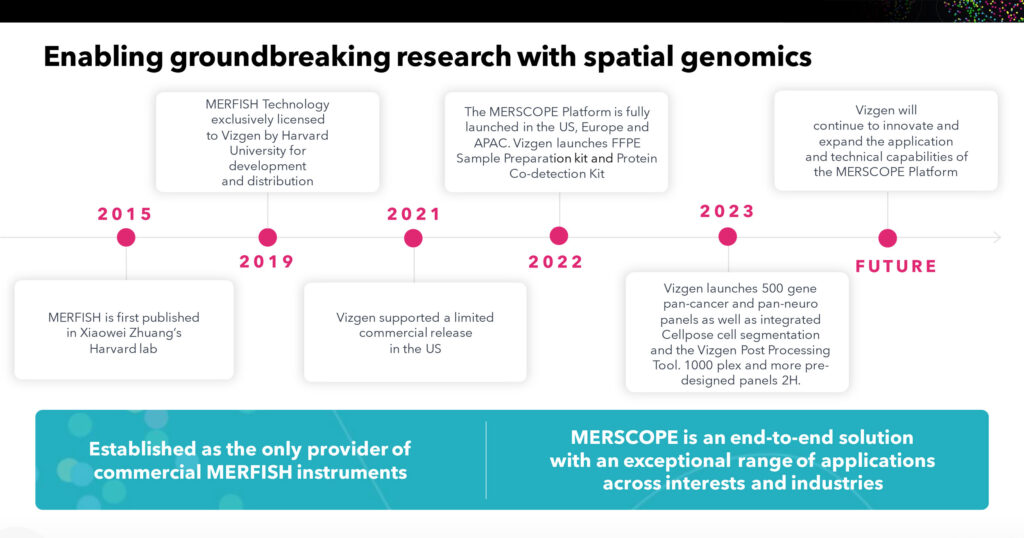By Melane Sampson

Closely-held Vizgen is pioneering next-generation genomics and benchmarking the spatial genomics field with its commercial MERSCOPE Platform, the industry’s first high plex in situ single-cell spatial genomics solution, an essential tool for advancing human health through drug discovery and development.
“With the MERSCOPE Platform, researchers are able to visualize biological systems that govern human health and disease for the very first time in their natural spatial location – enabling new insights into a wide range of tissue-scale basic research and translational medicine in oncology, immunology, neuroscience, cell and gene therapy, infectious disease, and developmental biology,” Terry Lo, President and CEO of Vizgen says in an interview with BioTuesdays.

“MERSCOPE combines single-cell and spatial multiomics analyses in one integrated system providing scientists with genome-scale acid imaging that is highly accurate and delivers unrivaled detection at subcellular resolution,” he adds.
The MERSCOPE Platform is powered by Vizgen’s proprietary Multiplexed Error-Robust Fluorescence in situ Hybridization, dubbed MERFISH, built upon an RNA imaging-based technique called single-molecule FISH or smFISH. MERFISH is a massively multiplexed single-molecule imaging technology for spatially resolved transcriptomics capable of simultaneously measuring the copy number and spatial distribution of hundreds to tens of thousands of RNA species in individual cells without the need for downstream sequencing.
Mr. Lo explains that to perform smFISH, fluorescently tagged oligo probes label RNA transcripts of interest and by counting the number of fluorescent RNA targets, scientists can determine each gene’s expression profile. “MERFISH expands on smFISH by adding combinatorial labeling, sequential rounds of imaging, and error robust barcoding to greatly increase the multiplexing capacity and enable spatially resolved, single-cell gene expression profiling,” he says.
By implementing a novel combinatorial barcoding scheme generated from sequential rounds of imaging consisting of a sequence of zeros and ones, each targeted gene in the custom-designed panel is assigned a unique binary barcode to dramatically increase multiplexing capacity.

“What makes the MERSCOPE Platform so accurate and consistent is that the barcode system is designed with error robustness, so if there is a readout error, the system can assign the readout to the nearest correct barcode,” Mr. Lo contends.
MERFISH spatial profiling technology enables scientists to spatially localize RNA transcripts with nanometer-scale resolution, profile a square centimeter of tissue in a single run, detect difficult-to-characterize lowly expressed genes with single-molecule sensitivity, perform custom multiplexing from hundreds of RNAs, map gene expression across whole tissues, and discover the complex arrangement of cell types and states, he adds.
“Mapping, or cell atlasing, is one of the big applications in single-cell genomics and spatial genomics today,” suggests Mr. Lo. “Cells and tissue exist in a three-dimensional space where communication networks and specific spatial arrangements are critical to proper function and spatial genomics provides us with this context delivering the unparalleled detail of single-cell sequencing with the ability to map the three-dimensional position of each cell, or transcript with a cell, precisely,” he says.
The MERSCOPE Platform can run up to 1,000 genes and map a million different cells within a tissue section – enabling the detection of up to a billion RNA transcripts within that section. This advances the possibility of creating a full picture of how cells behave and communicate within a dynamic environment, he adds.
Mr. Lo highlights that in late 2023, Vizgen announced the results of several studies published in the December 13, 2023 issue of Nature that leveraged MERFISH technology for spatial genomics insights providing scientists with a first-of-its-kind, previously invisible, full cellular map of the adult mouse brain. Researchers funded by the NIH BRAIN Initiative Cell Census Network (BICCN), an international collaborative, identified more than 5,300 cell types across 32 million cells and were able to map their location within the brain, he adds.
“We were thrilled that the MERSCOPE Platform backed by MERFISH technology contributed to this landmark neurobiological achievement that sets the stage for decades of study in this area,” Mr. Lo says. “The exceptionally high molecular and spatial resolution of MERFISH provided researchers with a comprehensive atlas of neuronal and non-neuronal cell types in the entire adult mouse brain.”
Mr. Lo outlines how spatial genomics is being leveraged in a number of research areas including the study of cancer. He notes that solid tumors are particularly complex in that they contain multiple cell types that interact with each other and with healthy surrounding tissue. Spatial genomics allows researchers to study tumors in their natural environment – enabling them to see how cells interact and the consequences of changes in their behavior.
“Because of the difficulty in replicating a tumor microenvironment in a controlled lab setting researchers don’t know a lot about how tumor cells interact, how they adapt over time, what goes wrong under different disease conditions, or how they respond to therapies but spatial genomics is revolutionizing this area of study by adding unprecedented insight,” he adds.
On the horizon, Mr. Lo says as the industry’s first mover in the spatial genomics field, Vizgen plans to launch several exciting new products over the next year. The company aims to continue to deliver innovative solutions, open up new research frontiers, and assist researchers in taking their studies to new depths with the MERSCOPE Platform backed by MERFISH technology.
“At Vizgen, we believe that there’s a world where every disease has a map and every cure has a path,” he adds.

• • • • •
To connect with Vizgen or any other companies featured on BioTuesdays, send us an email at editor@biotuesdays.com.







